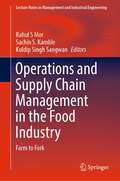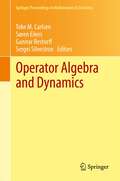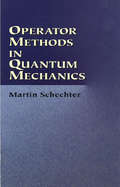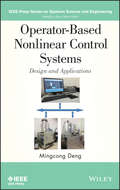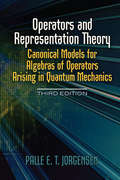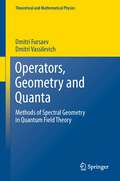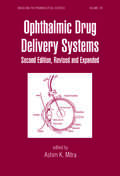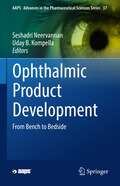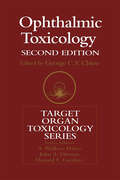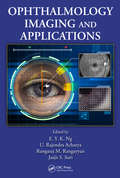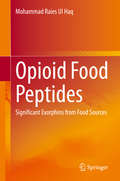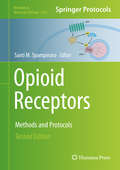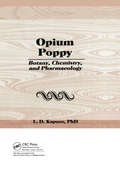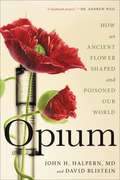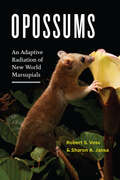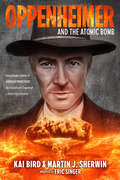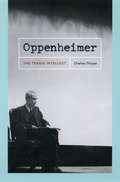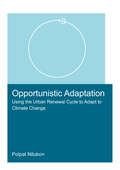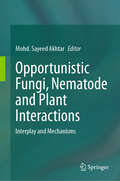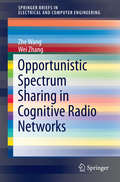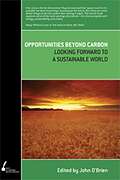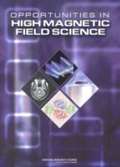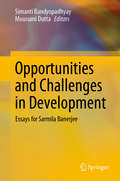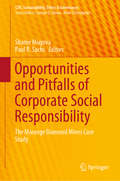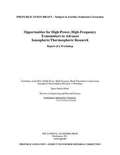- Table View
- List View
Operations and Supply Chain Management in the Food Industry: Farm to Fork (Lecture Notes in Management and Industrial Engineering)
by Kuldip Singh Sangwan Rahul S Mor Sachin S. KambleThis book offers effective and competitive food supply chains that are the consequence of technological innovation, collaboration, small agri-food business cases, entrepreneurial opportunities, cold chain technology management, disruptive technologies, and performance assessment through empirical analysis, case studies, and multimethod research in the food industry. The book comprehensively covers different interfaces of the food supply chain including procurement, processing, distribution, consumer, i.e., farm to fork. It provides solutions to various challenges such as globalization, food recalls, technological innovations, and consumer trust. This book will be of interest to researchers in the areas of the food supply chain, operations management, industrial engineering as well as professionals in the agri-food and allied industry.
Operator Algebra and Dynamics
by Toke M. Carlsen Søren Eilers Gunnar Restorff Sergei SilvestrovBased on presentations given at the NordForsk Network Closing Conference "Operator Algebra and Dynamics," held in Gjáargarður, Faroe Islands, in May 2012, this book features high quality research contributions and review articles by researchers associated with the NordForsk network and leading experts that explore the fundamental role of operator algebras and dynamical systems in mathematics with possible applications to physics, engineering and computer science. It covers the following topics: von Neumann algebras arising from discrete measured groupoids, purely infinite Cuntz-Krieger algebras, filtered K-theory over finite topological spaces, C*-algebras associated to shift spaces (or subshifts), graph C*-algebras, irrational extended rotation algebras that are shown to be C*-alloys, free probability, renewal systems, the Grothendieck Theorem for jointly completely bounded bilinear forms on C*-algebras, Cuntz-Li algebras associated with the a-adic numbers, crossed products of injective endomorphisms (the so-called Stacey crossed products), the interplay between dynamical systems, operator algebras and wavelets on fractals, C*-completions of the Hecke algebra of a Hecke pair, semiprojective C*-algebras, and the topological dimension of type I C*-algebras. Operator Algebra and Dynamics will serve as a useful resource for a broad spectrum of researchers and students in mathematics, physics, and engineering.
Operator Methods in Quantum Mechanics (Dover Books On Physics Series)
by Martin SchechterThis advanced undergraduate and graduate-level text introduces the power of operator theory as a tool in the study of quantum mechanics, assuming only a working knowledge of advanced calculus and no background in physics. The author presents a few simple postulates describing quantum theory, gradually introducing the mathematical techniques that help answer questions important to the physical theory; in this way, readers see clearly the purpose of the method and understand the accomplishment. The entire book is devoted to the study of a single particle moving along a straight line. By posing questions about the particle, the text gradually leads readers into the development of mathematical techniques that provide the answers. Lebesgue integration theory and complex variables are sometimes involved, but most of the book can be understood without them. Exercises at the end of each chapter provide helpful reinforcement.
Operator-Based Nonlinear Control Systems Design and Applications
by Mingcong DengEnables readers to master and apply the operator-theoretic approach Control of nonlinear systems is a multidisciplinary field involving electrical engineering, computer science, and control engineering. <P><P>Specifically, this book addresses uncertain nonlinearity. Beginning with how real plants are modeled as operator-based plants, the author develops a systematic methodology that enables readers to understand a quantitative stability result, a critical factor in any nonlinear control system's stability and performance. Operator-Based Nonlinear Control Systems: Design and Applications focuses on the operator-theoretic approach, offering detailed examples on how to apply it to network controlled systems. In addition to current research results, the author explores future research directions and applications of the operator-theoretic approach. The book begins with an introduction that defines nonlinear systems. Next, it covers: Robust right coprime factorization for nonlinear plants with uncertainties Robust stability of operator-based nonlinear control systems Tracking issues and fault detection issues in nonlinear control systems Operator-based nonlinear control systems with smart actuators Nonlinear feedback control for large-scale systems using a distributed control system device Throughout the book, discussions of actual applications help readers understand how the operator-theoretic approach works in practice. Operator-Based Nonlinear Control Systems is recommended for students and professionals in control theory engineering and applied mathematics. Working with this expertly written and organized book, they will learn how to obtain robust right coprime factorization for modeled plants. Moreover, they will discover state-of-the-technology research results on robust stability conditions as well as the latest system output tracking and fault detection issues that are challenging today's researchers.
Operators and Representation Theory: Canonical Models for Algebras of Operators Arising in Quantum Mechanics (Dover Books on Physics #Volume 147)
by Palle E.T. JorgensenSuitable for advanced undergraduates and graduate students in mathematics and physics, this three-part treatment of operators and representation theory begins with background material on definitions and terminology as well as on operators in Hilbert space. The introductory section concludes with a look at the imprimitivity theorem, which grounds in more mathematical language the work of Wigner on representations of the Poincaré and Galilei groups.The second part of the monograph addresses the algebras of operators in Hilbert space, broadening the mathematics used in earlier versions of quantum theory. There are many examples in which the Hamiltonian, the operator that translates a quantum system in time, can be written as a polynomial in elements of an underlying Lie algebra. This section deals with properties of such operators. Part 3 explores covariant representation and connections, with a particular focus on infinite-dimensional Lie algebras. Connections to mathematical physics are stressed throughout the text, which concludes with three helpful appendixes, including a Guide to the Literature.
Operators, Geometry and Quanta
by Dmitri Fursaev Dmitri VassilevichThis book gives a detailed and self-contained introduction into the theory of spectral functions, with an emphasis on their applications to quantum field theory. All methods are illustrated with applications to specific physical problems from the forefront of current research, such as finite-temperature field theory, D-branes, quantum solitons and noncommutativity. In the first part of the book, necessary background information on differential geometry and quantization, including less standard material, is collected. The second part of the book contains a detailed description of main spectral functions and methods of their calculation. In the third part, the theory is applied to several examples (D-branes, quantum solitons, anomalies, noncommutativity). This book addresses advanced graduate students and researchers in mathematical physics with basic knowledge of quantum field theory and differential geometry. The aim is to prepare readers to use spectral functions in their own research, in particular in relation to heat kernels and zeta functions.
Ophthalmic Drug Delivery Systems
by Ashim K. MitraThe second edition of this text assembles significant ophthalmic advances and encompasses breakthroughs in gene therapy, ocular microdialysis, vitreous drug disposition modelling, and receptor/transporter targeted drug delivery.
Ophthalmic Product Development: From Bench to Bedside (AAPS Advances in the Pharmaceutical Sciences Series #37)
by Uday B. Kompella Seshadri NeervannanThis is a comprehensive textbook addressing the unique aspects of drug development for ophthalmic use. Beginning with a perspective on anatomy and physiology of the eye, the book provides a critical appraisal of principles that underlie ocular drug product development. The coverage encompasses topical and intraocular formulations, small molecules and biologics (including protein and gene therapies), conventional formulations (including solutions, suspensions, and emulsions), novel formulations (including nanoparticles, microparticles, and hydrogels), devices, and specialty products. Critical elements such as pharmacokinetics, influence of formulation technologies and ingredients, as well as impact of disease conditions on products development are addressed. Products intended for both the front and the back of the eye are discussed with an eye towards future advances.
Ophthalmic Toxicology
by G. C. ChiouThoroughly revised and updates, this new edition of Ophthalmic Toxicology retains its uniqueness in covering all aspects of ophthalmic toxicology. With chapters from leading authorities incorporating the latest developments in the field, including a new chapter on the molecular basis of ophthalmic toxicity, this edition covers such topics as:*t
Ophthalmological Imaging and Applications
by Jasjit S. Suri Rangaraj M. Rangayyan U. Rajendra Acharya E. Y. K. NgEdited by and featuring contributions from world-class researchers, Ophthalmological Imaging and Applications offers a unified work of the latest human eye imaging and modeling techniques that have been proposed and applied to the diagnosis of ophthalmologic problems, including inflammation, cataracts, diabetic retinopathy, and glaucoma. With a foc
Opioid Food Peptides: Significant Exorphins from Food Sources
by Mohammad Raies Ul HaqThis book compiles the latest research on food-derived opioid peptides, particularly those derived from milk. It describes in detail the structure, classification and, more importantly, physiological functions of these peptides. Presenting an interesting overview of the opioid receptors and receptor ligands, it examines the absorption, transport and degradation of these opioid peptides. Further, it highlights the production of β-casomorphins from only one variant of β-casein and its biological activities, and explores the generation of αb‐lactorphin from bovine αb‐lactalbumin and βb‐lactorphin. The book also includes a section on the use of advanced biochemical and pharmacological techniques to analyze opioid peptides, discussing the extraction of protein from food sources, protein purification followed by SGID, filtration of peptides and analysis using analytical HPLC. Lastly, it offers insights into the significance of these peptides in the pharmaceutical industry and their potential role as therapeutic agents.This timely book is useful for researchers and students in the field of food sciences, dairy science, agriculture and pharmacology. It is also of interest to industry experts.
Opioid Receptors: Methods and Protocols (Methods in Molecular Biology #2201)
by Santi M. SpampinatoThis second edition presents an up-to-date chapters describing the most relevant and novel techniques employed to study the opioid receptors. Chapters detail transcriptional and post-transcriptional analysis, cellular detection of opioid receptors, analysis of signaling events modulated by opioid receptors, model systems to studying opioid receptor-mediated functions, and behavioral effects mediated by opioid receptors. Written in the highly successful Methods in Molecular Biology series format, chapters include introductions to their respective topics, lists of the necessary materials and reagents, step-by-step, readily reproducible laboratory protocols, and tips on troubleshooting and avoiding known pitfalls. Authoritative and cutting-edge, Opioid Receptors: Methods and Protocols, Second Edition aims to ensure successful results in the further study of this vital field.
Opium Poppy: Botany, Chemistry, and Pharmacology
by L. KapoorHere is an in-depth examination of the opium poppy--the first medicinal plant known to mankind. In Opium Poppy: Botany, Chemistry, and Pharmacology, author L. D. Kapoor provides readers with a comprehensive resource on poppy production from seed to alkaloid. He explores the opium poppy?s origin, distribution, chemistry, and uses and abuses from ancient civilizations through the present day. He covers plant and seed production and crop improvement and explores in detail the chemical and pharmaceutical by-products of the opium poppy. The book begins with a historical overview of the origin and use of opium poppy in ancient civilizations such as Greece, Egypt, and Mesopotamia. Chapters that follow contain detailed information on:botanical studiescytogenics and plant breedingagronomy, including insect and pest control measuresphysiological and anatomical studieschemical and pharmacological aspects of opium alkaloidsbiosynthesis and physiology of opium alkaloidsthe occurrence and role of alkaloids in plantsthe evaluation of analgesic actions of morphine in various pain models in experimental animalsOpium Poppy: Botany, Chemistry, and Pharmacology is a useful reference for professionals and students of pharmacy, botany, chemistry, medicine, and pharmacology who need a better overall understanding of this ancient plant and its (potential) modern usage.
Opium: How an Ancient Flower Shaped and Poisoned Our World
by David Blistein John H. Halpern"A landmark project." -- Dr. Andrew Weil"Engrossing and highly readable." -- Sam Quinones"An astonishing journey through time and space." -- Julie Holland, MD"The most important, provocative, and challenging book I've read in a long time." -- Laurence BergreenFrom a psychiatrist on the frontlines of addiction medicine and an expert on the history of drug use, comes the "authoritative, engaging, and accessible" (Booklist) history of the flower that helped to build -- and now threatens -- modern society.Opioid addiction is fast becoming the most deadly crisis in American history. In 2018, it claimed nearly fifty thousand lives -- more than gunshots and car crashes combined, and almost as many Americans as were killed in the entire Vietnam War. But even as the overdose crisis ravages our nation -- straining our prison system, dividing families, and defying virtually every legislative solution to treat it -- few understand how it came to be. Opium tells the extraordinary and at times harrowing tale of how we arrived at today's crisis, "mak[ing] timely and startling connections among painkillers, politics, finance, and society" (Laurence Bergreen). The story begins with the discovery of poppy artifacts in ancient Mesopotamia, and goes on to explore how Greek physicians and obscure chemists discovered opium's effects and refined its power, how colonial empires marketed it around the world, and eventually how international drug companies developed a range of powerful synthetic opioids that led to an epidemic of addiction. Throughout, Dr. John Halpern and David Blistein reveal the fascinating role that opium has played in building our modern world, from trade networks to medical protocols to drug enforcement policies. Most importantly, they disentangle how crucial misjudgments, patterns of greed, and racial stereotypes served to transform one of nature's most effective painkillers into a source of unspeakable pain -- and how, using the insights of history, state-of-the-art science, and a compassionate approach to the illness of addiction, we can overcome today's overdose epidemic. This urgent and masterfully woven narrative tells an epic story of how one beautiful flower became the fascination of leaders, tycoons, and nations through the centuries and in their hands exposed the fragility of our civilization.
Opossums: An Adaptive Radiation of New World Marsupials
by Robert S. Voss Sharon A. JansaThe definitive volume on opossums, a group of ecologically and scientifically important mammals, covering natural history, evolution, behavior, and biogeography.Opossums are the most diverse and ecologically important group of New World marsupials, although only the Virginia opossum is familiar to North American residents. In fact, many species of opossums are found in Neotropical rainforests, savannas, and other habitats, where they are key participants in food webs and other ecological relationships. One species, the short-tail opossum (Monodelphis domestica), has recently become a model organism for biomedical researchers. Eclipsed in the public imagination by their Australian relatives, opossums remained for many years a somewhat obscure group, of interest primarily to taxonomists and students of mammalian reproduction. While thousands of scientific articles have appeared in recent years on opossum systematics, morphology, behavior, physiology, genetics, and ecology, this important but widely scattered literature has never been effectively summarized—until now. In Opossums, the first book-length treatment of these fascinating organisms, recognized authorities Robert S. Voss and Sharon A. Jansa synthesize a wide range of available information about the diversity, comparative biology, and natural history of the opossum. Peering into every biological facet of the lives of these long-neglected mammals, the volume includes• introductory chapters explaining the paleontological and biogeographic context for opossum evolution• an overview of the extant fauna, which includes over 100 species in 18 genera • a section devoted to opossum phenotypes: morphology, physiology, and behavior• detailed information on opossum natural history, including habitats, diets, predators, and parasites• in-depth and novel interpretations of opossums' adaptive radiation in a phylogenetic contextIntended for undergraduate biology majors, graduate students, and research professionals, this coherent and original portrait of opossums will be of particular interest to mammalogists, evolutionary biologists, and Neotropical field biologists as well as biomedical researchers working with Monodelphis domestica as a model organism.
Oppenheimer and the Atomic Bomb: Young Readers Edition of AMERICAN PROMETHEUS: The Triumph and Tragedy of J. Robert Oppenheimer
by Kai Bird Martin J. SherwinA young readers edition of the #1 New York Times bestselling, Pulitzer Prize-winning book American Prometheus was the inspiration for the blockbuster film, Oppenheimer.This brand-new edition introduces the next generation to one of the twentieth century's most iconic and complex global figures.J. Robert Oppenheimer was a brilliant physicist who led the American effort to build the atomic bomb during World War II, and who later found himself confronting the moral consequences of the revolutionary weapon he helped create. Readers of all ages will witness the rise and fall of a scientific and historical icon in this masterful new edition. Exploring his childhood, his secret work on the bomb, his central role in the Cold War, and his tragic downfall, this quintessential biography is history at its finest. Filled with dozens of photographs and updated information, this riveting and deeply informative account is now available to a middle and high school audience.
Oppenheimer: The Tragic Intellect (Interspecific Interactions Ser.)
by Charles ThorpeAt a time when the Manhattan Project was synonymous with large-scale science, physicist J. Robert Oppenheimer (1904–67) represented the new sociocultural power of the American intellectual. Catapulted to fame as director of the Los Alamos atomic weapons laboratory, Oppenheimer occupied a key position in the compact between science and the state that developed out of World War II. By tracing the making—and unmaking—of Oppenheimer’s wartime and postwar scientific identity, Charles Thorpe illustrates the struggles over the role of the scientist in relation to nuclear weapons, the state, and culture. A stylish intellectual biography, Oppenheimer maps out changes in the roles of scientists and intellectuals in twentieth-century America, ultimately revealing transformations in Oppenheimer’s persona that coincided with changing attitudes toward science in society. “This is an outstandingly well-researched book, a pleasure to read and distinguished by the high quality of its observations and judgments. It will be of special interest to scholars of modern history, but non-specialist readers will enjoy the clarity that Thorpe brings to common misunderstandings about his subject.”—Graham Farmelo, Times Higher Education Supplement “A fascinating new perspective. . . . Thorpe’s book provides the best perspective yet for understanding Oppenheimer’s Los Alamos years, which were critical, after all, not only to his life but, for better or worse, the history of mankind.”—Catherine Westfall, Nature
Opportunistic Adaptation: Using the Urban Renewal Cycle to Adapt to Climate Change (IHE Delft PhD Thesis Series)
by Polpat NilubonUrban climate adaptation currently focusses mainly on hazards but often ignores opportunities which arise in both space and time. Opportunistic Adaptation provides a rationalized approach to mainstream measures for climate adaptation into urban renewal cycles. Adaptation opportunities are identified by projecting the lifespans of urban assets into the future to obtain an operational urban adaptation agenda for the future. Upscaling of the adaptation process is done by synchronizing the end-of-lifecycle of a group of assets to develop adaptation clusters that comprise multiple dwellings, infrastructure as well as public spaces. An extensive catalogue of adaptation measures for different scale-levels ensures flexibility in the type of measures that can be integrated. Sequencing the adaptation measures over long periods of time provides insight and flexibility in the long-term protection standards that can be achieved. By applying a design-centered approach, the potentials of obtaining co-benefits in the urban landscape are maximized. Potentials of clustering of nature-based solutions are being considered which ensures to maximize the delivery of ecosystem services. This research aims to assess \the adaptation potential of Bangkok, based on a case study area (Lat Krabang) by mapping the adaptation opportunities and flood vulnerability. The resulting outputs will contribute to the development of a flexible and inclusive FRM strategy.
Opportunistic Fungi, Nematode and Plant Interactions: Interplay and Mechanisms
by Mohd. Sayeed AkhtarThis book covers the fundamental and applied characteristics of opportunistic (OP) fungi, plant parasitic nematodes (PPN), and plant interactions. Fungal behavior and cultivation, physiological and molecular changes in relation to hosts and pathogens, and the mechanistic aspects of their management strategies are also covered in this volume. In the diverse agro-climatic conditions of the world, PPN has been identified as the most damaging pest to a variety of commercial and agro-important crop plants. Various chemical nematicides have been widely employed to treat nematode infection in recent decades, but use of these chemicals has been restricted due to widespread concerns about human health and environmental safety. In this regard, rhizospheric microorganisms can act as a first line of defense against pathogen attacks on the root and play a critical role in the management of plant diseases caused by PPN. The OP might directly parasitize the PPN by secreting metabolic chemicals that affect the viability of one or more phases of the nematode's life cycle. This book is of interest and useful to teachers, researchers, and professionals working on plant nematology, pathology, ecology, soil science, host-plant interactions, microbial ecology, and industries. Aside from that, this book also serves as additional reading material for undergraduate and graduate students all over the globe, as well as agricultural scientists and policymakers.
Opportunistic Spectrum Sharing in Cognitive Radio Networks
by Wei Zhang Zhe WangThis Springer Brief investigates spectrum sharing with limited channel feedback in various cognitive radio systems, such as point-to-point, broadcast scheduling and ad-hoc networks. The design aim is to optimally allocate the secondary resources to improve the throughput of secondary users while maintaining a certain quality of service for primary users. The analytical results of optimal resource allocation are derived via optimization theory and are verified by the numerical results. The results demonstrate the secondary performance is significantly improved by limited feedback and is further improved by more feedback bits, more secondary receivers and more primary side information.
Opportunities Beyond Carbon: Looking Forward to a Sustainable World
by John O'BrienOpportunities Beyond Carbon presents climate change as potentially the 'best crisis we ever had'. It maps the many opportunities for communities large and small, local and international, making the transition to a low carbon economy. John O'Brien has compiled essays by key politicians, investors, business people, activists and academics on how to make the most of the current predicament. This fresh, lucid and practical optimism for the future offers a foundation for an entirely new and proactive attitude to climate change.
Opportunities In High Magnetic Field Science
by National Research Council of the National AcademiesHigh-field magnets—those that operate at the limits of the mechanical and/or electromagnetic properties of their structural materials—are used as research tools in a variety of scientific disciplines. The study of high magnetic fields themselves is also important in many areas such as astrophysics. Because of their importance in scientific research and the possibility of new breakthroughs, the National Science Foundation asked the National Research Council to assess the current state of and future prospects for high-field science and technology in the United States. This report presents the results of that assessment. It focuses on scientific and technological challenges and opportunities, and not on specific program activities. The report provides findings and recommendations about important research directions, the relative strength of U.S. efforts compared to other countries, and ways in which the program can operate more effectively.
Opportunities and Challenges in Development: Essays for Sarmila Banerjee
by Mousumi Dutta Simanti BandyopadhyayThis book provides a broad overview of the current research on various aspects of development, with a focus on India. The content and treatment of the subject of development in this volume is distinctive in many ways. It is a balanced mix of theory and practical elements, dealing with a number of issues at micro as well as macro levels. The analyses of the current socio-economic problems are attempted in an elegant yet simple manner which makes it equally useful for an aspiring researcher in economics or any inter disciplinary field. The methodologies of the articles include analytical verbal argumentative logic, theoretical constructs or different versions of statistical, econometric or programming techniques. It also contains well written survey articles, which are useful in grasping the fundamental research issues and in tracing the progress of research in an area. The general scope of the book is very wide as the readership can include researchers, scholars, graduate and undergraduate students, policy makers and practitioners. Though the contributors are primarily scholars in the field of Economics or Statistics, the book contains useful takeaways for those working in the area of Development. It will also be of interest to policy makers and practitioners interested in development issues, and to post graduate students in Economics or any field, in social science, management or development.
Opportunities and Pitfalls of Corporate Social Responsibility: The Marange Diamond Mines Case Study (CSR, Sustainability, Ethics & Governance)
by Shame Mugova Paul R. SachsThis book addresses key aspects of corporate social responsibility (CSR) and explores them from a variety of perspectives in a case study on the Marange diamond mines in Zimbabwe. The business case of the Marange mines is presented to demonstrate the challenge of practicing social responsibility while considering and balancing the needs of a developing nation, environmental protection, community involvement and international business. Lessons learned from the case study will help business leaders and strategists in developing countries and multinational corporations to better understand and employ CSR principles so as to enhance sustainability and social impact. Further, the book provides a unique combination of academic, industrial and local approaches.
Opportunities for High-Power, High-Frequency Transmitters to Advance Ionospheric/Thermospheric Research: Report of a Workshop
by Committee on the Role of High-Power High-Frequency-Band Transmitters in Advancing Ionospheric/Thermospheric Research: A Workshop"Opportunities for High-Power, High-Frequency Transmitters to Advance Ionospheric/Thermospheric Research" is the summary of a workshop convened by the Space Studies Board of the National Research Council in May 2013. The request for this workshop was informed by the sponsors' awareness of the possibility that tight budgets would result in the Department of Defense's curtailment or even termination1 of support for the High Frequency Active Auroral Research Program (HAARP), which includes the world's highest-power and most capable high-frequency transmitter - "heater" - for ionospheric research. Although the workshop was organized to consider the utility of heaters in upper atmospheric research in general, it had a specific focus on the HAARP transmitter facility, which is located in a remote part of southeastern Alaska. Research conducted by the ionospheric modifications community - a community that uses high-frequency transmitters to inject energy in the ionosphere and measure its effects using ground and space-based diagnostics - is focused on understanding the interaction of radio waves with the ionospheric plasma, the local consequences of heating in the ionosphere, and studies of non-linear plasma physics processes. The workshop provided a forum for information exchange between the comparatively small group of scientists engaged in programs of upper atmospheric research using high-power high-frequency radar transmitters and the larger ionospherethermosphere-magnetosphere research community. This report examines the state of the art in active ionospheric and thermospheric research; considers the fundamental research areas in ionospheric science that can be addressed using high-power high-frequency-band transmitters; discusses emerging science questions that might benefit from active ionospheric experiments in the sub-auroral zone; and considers ways to combine similar facilities to perform global ionospheric science. The report also examines research opportunities that might arise from the relocation of the AMISR incoherent scatter radar from the Poker Flat Research Facility in Poker Flat, AK to Gakona, AK, the location of the HAARP facility.
